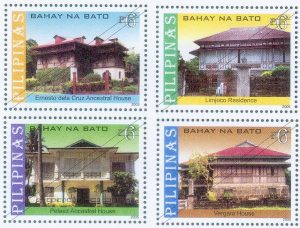Trivia about Philippine Ancestral Houses or Bahay na Bato
ERNESTO DELA CRUZ ANCESTRAL HOUSE – Mabalacat, Pampanga. Date of construction- Late 1800’s. The grand house is a two-storey structure with a wooden upper floor and stone/concrete ground floor. The structure is supported by massive square columns and adobe arches. The massiveness of the house is softened by sliding louvered windows with the traditional ventanillas. The continuous ‘media agua’ below the roof enchances the elegant composition of the house. An unsual feature of this house is the interesting hip roof system enhanced by several dormers.
LIMJOCO HOUSE – Candaba, Pampanga. Date of construction- 1890’s. The Limjoco House is a two storey ‘bahay-na-bato’. The ground floor with walls of adoba stone is straight forward in design with minimal ornamentations. The upper floor exterior wall is tastefully punctured with sliding capiz windows interpersed with decorated wood panels. The vetanillas complete the uncluttered design of the house. As additional protection from the rains for the upper floor windows, a continuous ‘media agua’ was installed. Supported by curved rods. The house is still in good condition. During the time of the Huk invasion, Hukbalahaps entereo this house looking for guns.
PELAEZ ANCESTRAL HOUSE – Medina, Misamis Oriental. Another variation of the ‘bahay-na-bato’ is this two storey house constructed of wood and concrete al the ground floor. The graceful proportion and tasteful details contribute to the quality aesthetics of the house. The second floor has the traditional sliding capiz windows with balustrated ventanillas. Above the windows is a series of transoms with traceries. The design is basically square in plan, broken only by the central portion of the facade on the second floor which juts out over the main entry. This structure is the ancestral house of former vice-president, senator and ambassadci Emmanuel Pelaez.
VERGARA HOUSE – Guagua, Pampanga. Date of construction- Late 1700’s. This diminutive ‘bahay-na-bato’ of fine proportion features a lower level enclosed with thick walls of adobe blocks. The interior is a showcase of quality craftmanship on wood carvings evident in the clerestory, transoms, wood frets and religious engraving on the columns. One of the original owners, Quintin Delos Santas was known as Huwes de Ganados’. The place was known as Pueblo de Betis.
ILAGAN ANCESTRAL HOUSE – Taal, Batangas. Built in 1870. It is a good example of a geometric style of the Filipino Hispanic house because there are hardly any decoration on the facade. The house relies mainly on the structural elements for its beauty Capiz windows with diamond and square patterns cover entirely the upper facade. The ground floor is bare and makes a good contrast. The interior has gold leaf neo-gothic arches and the decorations on the ceiling were made by Japanese artisans.
LASALA-GUARIN HOUSE – Juban, Sorsogoo. Date of construction 1914. This house is a ‘bahay na bato’ type structure, enclosed with adobe stone on the grouno floor and wood panels on the second floor. The house is strategically situated on the corner of a main road Junction. It features a continuous “media agua’ supported by wooden poles, protecting the large window openings of the second floor. The ground floor is divided into three segments with three double panel doors. On the second floor above each door are four-panel sliding capiz windows with persianas and with ventanilla’s underneath. Between these persianas which are flanked by another set of wood panels embellished with a cross shaped design. Before World War II it was used as a school. During the war it became a temporary residence of Japanese soldiers in the area. After the war it became popufar venue for social events such as parties and dances.
CLAPAROLS HOUSE – Talisay City, Negros Occidental. Date of construction-Early 1900’s. Large and Symmetrical, the Claparols house is typical of the hacienda houses of the sugar barons of the colonial period. The tall houses overlook the entire hacienda. The brick and stone ground floor is simple. The wood panel walls on the second floor is punctuated with French windows on all sides. These opened to a wrap-around balcony. A continuous “media-agua”, provides additional protection for the second floor. The house was one of the most prominent structures at the peak of the sugar industry. The original Filipino owner was General Aniceto Locsin, the President of the First Republic of Negros, and was one of the leaders of the revolution against Spain.
GLICERIA MARELLA VILLAVICENCIO ANCESTRAL HOUSE – Taal, Batangas. Date of construction-1880. This type of house is more open sometimes with an exterior stairway entering into an ornate balcony. It has more decorations on the facade. The media agua is a permanent awning to protect the windows from the elements.
Stamps featuring the Philippine Ancestral Houses or Bahay na Bato


Recent Comments